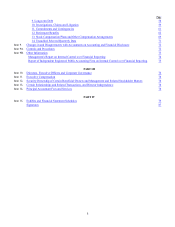Northrop Grumman 2014 Annual Report Download - page 19
Download and view the complete annual report
Please find page 19 of the 2014 Northrop Grumman annual report below. You can navigate through the pages in the report by either clicking on the pages listed below, or by using the keyword search tool below to find specific information within the annual report.
NORTHROP GRUMMAN CORPORATION
-10-
Our risk varies with the type of contract. Due to their nature, fixed-price contracts inherently tend to have more risk
than cost type contracts. In 2014, approximately half of our sales were derived from fixed-price contracts. We
typically enter into fixed-price contracts where costs can be more reasonably estimated based on experience. In
addition, our contracts contain provisions relating to cost controls and audit rights. If the terms specified in our
contracts are not met, our profitability may be reduced and we may incur a loss. Fixed-price development work
comprises a small portion of our fixed-price contracts. This type of work is inherently more uncertain as to future
events than production contracts, and, as a result, there is typically more variability in estimates of the costs to
complete the development stage. As work progresses through the development stage into production, the risks
associated with estimating the total costs of the contract are typically reduced. While management uses its best
judgment to estimate costs associated with fixed-price development contracts, future events could result in either
upward or downward adjustments to those estimates. Under cost type contracts, allowable costs incurred by the
contractor are generally subject to reimbursement plus a fee. We often enter into cost type contracts for development
programs with complex design and technical challenges. These cost type programs typically have award or incentive
fees that are subject to uncertainty and may be earned over extended periods or towards the end of the contract. In
these cases, the associated financial risks are primarily in recognizing profit, which ultimately may not be earned, or
program cancellation if cost, schedule, or technical performance issues arise.
Because of the significance of the judgment and estimation processes described above, it is possible that materially
different amounts could be obtained if different assumptions were used or if the underlying circumstances were to
change. Changes in underlying assumptions, circumstances or estimates could have a material adverse effect upon
the profitability of one or more of the affected contracts and on our overall financial position, results of operations
and/or cash flows. See Critical Accounting Policies, Estimates and Judgments in Part II, Item 7.
Our business could be negatively impacted by cyber and other security threats or disruptions.
As a defense contractor, we face various cyber and other security threats, including attempts to gain unauthorized
access to sensitive information and networks; insider threats; threats to the safety of our directors, officers and
employees; threats to the security of our facilities and infrastructure; and threats from terrorist acts or other acts of
aggression. Our customers, suppliers and subcontractors face similar threats. Although we utilize various procedures
and controls to monitor and mitigate the risk of these threats, there can be no assurance that these procedures and
controls will be sufficient. These threats could lead to losses of sensitive information or capabilities, harm to
personnel, infrastructure or products, and/or damage to our reputation as well as our or our suppliers’ or
subcontractors’ ability to perform on our contracts.
Cyber threats are evolving and include, but are not limited to, malicious software, destructive malware, attempts to
gain unauthorized access to data, disruption or denial of service attacks, and other electronic security breaches that
could lead to disruptions in mission critical systems, unauthorized release of confidential or otherwise protected
information (ours or that of our customers or partners), and corruption of data, networks or systems. In addition, we
could be impacted by cyber threats or other disruptions or vulnerabilities found in products we use or in our
partners’ or customers’ systems that are used in connection with our business. These events, if not prevented or
effectively mitigated, could damage our reputation, require remedial actions and lead to loss of business, regulatory
actions, potential liability and other financial losses.
We provide cyber and information technology systems, products and services to various customers (government and
commercial) who also face cyber threats. Our systems, products and services may themselves be subject to cyber
threats and/or they may not be able to detect or deter threats, or effectively to mitigate resulting losses. These losses
could adversely affect our customers and our company.
The impact of these factors is difficult to predict, but one or more of them could result in the loss of information or
capabilities, harm to individuals or property, damage to our reputation, loss of business, regulatory actions and
potential liability, any one of which could have a material adverse effect on our financial position, results of
operations and/or cash flows.
Pension and medical expenses associated with our retirement benefit plans may fluctuate significantly depending
upon changes in actuarial assumptions, future investment performance of plan assets and legislative or other
regulatory actions.
A substantial portion of our current and retired employee population is covered by pension and other post-retirement
benefit plans, the costs of which are dependent upon various assumptions, including estimates of rates of return on
benefit plan assets, discount rates for future payment obligations, mortality assumptions, rates of future cost growth
























